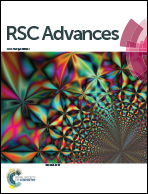A pH-sensitive and sustained-release oral drug delivery system: the synthesis, characterization, adsorption and release of the xanthan gum-graft-poly(acrylic acid)/GO–DCFP composite hydrogel†
Abstract
In this study, graphene oxide (GO) was successfully prepared using the improved Hummers method, and the prepared GO powder was dissolved in distilled water and subjected to ultrasonic stripping. Diclofenac potassium (DCFP) was selected as a model drug to systematically evaluate the adsorption mechanism of DCFP by GO. Different reaction models were constructed to fit the adsorption kinetics and adsorption isotherms of DCFP on GO, in order to further explore the underlying adsorption mechanism. The results demonstrated that the pseudo-second-order kinetic model and Freundlich model could better delineate the adsorption process of DCFP by GO. Both π–π stacking and hydrophobic interaction were mainly involved in the adsorption process, and there were electrostatic interaction and hydrogen bonding at the same time. Then, the xanthan gum-graft-poly(acrylic acid)/GO (XG-g-PAA/GO) composite hydrogel was synthesized by in situ polymerization as a slow-release drug carrier. For this reason, a XG-g-PAA/GO–DCFP composite hydrogel was synthesized, and its in vitro drug release and pharmacokinetic data were assessed. The results showed that the synthesized XG-g-PAA/GO composite hydrogel had a certain mechanical strength and uniform color, indicating that GO is evenly distributed in this composite hydrogel. Moreover, the results of a swelling ratio test demonstrated that the swelling ratios of the XG-g-PAA/GO composite hydrogel were significantly increased with increasing pH values, implying that this material is sensitive to pH. The in vitro drug release experiment showed that the cumulative release of DCFP after 96 h was significantly higher in artificial intestinal fluid than in artificial gastric fluid. These findings indicate that the XG-g-PAA/GO–DCFP composite hydrogel exhibits pH sensitivity under physiological conditions. Besides, the results of in vivo pharmacokinetic analysis revealed that the t1/2 of DCFP group was 2.03 ± 0.35 h, while that of the XG-g-PAA/GO–DCFP composite hydrogel group was 10.71 ± 2.04 h, indicating that the synthesized hydrogel could effectively prolong the drug action time. Furthermore, the AUC(0–t) of the DCFP group was 53.99 ± 3.18 mg L−1 h−1, while that of the XG-g-PAA/GO–DCFP composite hydrogel group was 116.79 ± 14.72 mg L−1 h−1, suggesting that the bioavailability of DCFP is greatly enhanced by this composite hydrogel. In conclusion, this study highlights that the XG-g-PAA/GO–DCFP composite hydrogel can be applied as a sustained-release drug carrier.



 Please wait while we load your content...
Please wait while we load your content...